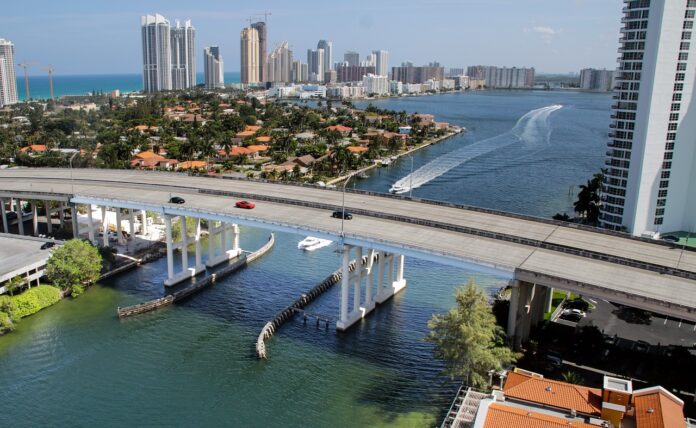The beautiful American city of Miami is not only an incredible place for tourism and relaxation but also a historical landmark known for its uniqueness. These fascinating facts about this sunny city will enrich your knowledge and impress your American friends.
Interesting Facts about Miami:
- Rare Snowfall: Snow remains a rare phenomenon in Miami. The only recorded snowfall in the city occurred on January 19, 1977. Residents still remember the extraordinary event, which has never been repeated.
- Agricultural and Textile Hub: While Miami is known for its tourism, it also plays a key role in agriculture, especially in producing tropical fruits such as mangoes, avocados, and tomatoes. The city’s textile industry has become less dominant over the years, though it remains relevant.
- International Financial Center: Miami continues to be a major hub for international banking, with many large global banks maintaining headquarters or major branches here, making it a financial center for Latin America.
- Rollerblade ATM: Miami made history by introducing the first ATM for rollerbladers in the 1960s, but while the machine no longer exists, it remains a quirky part of the city’s lore.
- International Flights and Cargo: Miami International Airport (MIA) continues to handle the most international cargo of any U.S. airport, and it remains one of the busiest for international passenger flights, ranking second in 2024.
- Park Diversity: Miami still boasts an impressive number of parks, with more than 800 green spaces. The city’s focus on outdoor living remains strong, with Everglades National Park being a unique wilderness escape near the metropolis. The commitment to sustainability has grown, with more eco-friendly initiatives in park management.
- Tourism Backbone: Miami continues to thrive on tourism. In 2023, the city welcomed over 15 million visitors, with tourism contributing to more than 70% of its economic activity. The number of international visitors, especially from Latin America and Europe, remains high.
- Service Industry: Due to its tourism-driven economy, around 12% of the workforce is employed in the hospitality sector, including hotels, restaurants, and beach-related services.
- Ski Resort Myth: Miami doesn’t have an actual ski resort; however, artificial snow and indoor skiing have become popular attractions. This is more of a themed activity than a real ski resort.
- Cultural Hub: Miami remains a significant center for arts, music, and culture. The Miami City Ballet and the New World Symphony continue to attract global attention. Miami also hosts Art Basel, one of the most prestigious art fairs in the world, drawing international artists and collectors.
- Burger King Origins: The first Burger King, founded in 1954, remains a part of Miami’s food history. The original location no longer exists, but Burger King’s presence and legacy are still strong in the city.
- Sunscreen Invention: Miami is still proud of being the birthplace of sunscreen, which was invented in 1940. Modern formulations of sunscreen trace their origins back to this creation.
- Indigenous History: The city’s name originates from the Mayaimis tribe that lived around Lake Okeechobee. Today, Miami continues to recognize its Native American heritage through local events and historical sites.
- Founded by a Woman: Miami is one of the few major U.S. cities founded by a woman, Julia Tuttle, known as the “Mother of Miami.” The city honors her legacy with monuments and historical references.
- Population Growth: As of 2024, Miami’s population stands at approximately 450,000 residents. The city has grown, but remains compact compared to other U.S. cities.
- Language Diversity: Miami remains one of the most linguistically diverse cities in the U.S. Around 75% of the population speaks a language other than English at home, primarily Spanish and Haitian Creole. English-speaking residents have increased slightly due to recent immigration trends.
- Pirate History: Miami was indeed a haven for pirates in the 17th and 18th centuries. Although treasure hunts are no longer common, the pirate history is celebrated through festivals and tours.
- Swampy Beginnings: Before its development, Miami was primarily a swampy area. Through urban planning and engineering, the city has transformed, but its tropical wetlands are still preserved in areas like the Everglades.
- Economic Divide: The economic gap between the wealthy and the poor remains pronounced in 2024. Gentrification has increased in several neighborhoods, leading to rising property prices and further widening the gap between rich and poor.
- Scuba Diving Capital: Miami is still renowned as a diving hotspot, with numerous shipwrecks and coral reefs attracting divers from around the world. Artificial reef programs continue to grow, adding more underwater exploration sites.
- Miami River: The Miami River remains a central waterway dividing the city and is vital for its shipping industry. Recent urban revitalization efforts have made the riverfront a popular area for dining and recreation.
- Metro Expansion: While the city’s swampy geography once made a subway impossible, Miami’s public transportation has improved with the expansion of the Metromover, which now covers more areas of the city as of 2024. Plans for further infrastructure improvements continue.
- Environmental Efforts: Miami has been consistently recognized as one of the cleanest cities in the U.S., thanks to environmental policies and efforts to reduce pollution, including banning single-use plastics and emphasizing green energy.
- Gianni Versace’s Legacy: The memory of the assassination of designer Gianni Versace on Ocean Drive in 1997 still resonates. His former mansion is now a luxury hotel and tourist attraction.
- Spanish-Language Media Capital: Miami remains the hub for Spanish-language television and media, with networks like Telemundo and Univision based in the city, serving millions of Spanish-speaking viewers across the U.S.
- Scenic Views: Miami continues to be ranked highly for its impressive views, with its skyline and beachfront attracting photographers and tourists. It consistently appears in global rankings for picturesque cities, currently sitting at 18th worldwide in 2024.
